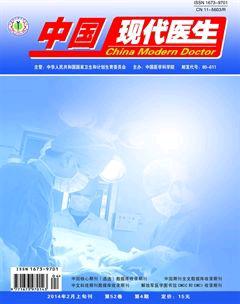增殖诱导配体在多发性骨髓瘤中的表达及临床意义
张桂华 陈令松 张秋荣等
[摘要] 目的 定量分析多发性骨髓瘤患者化疗前后外周血单个核细胞和血浆中增殖诱导配体(APRIL)mRNA及蛋白的表达水平。方法 应用酶联免疫吸附试验(ELISA)及实时荧光定量聚合酶链反应(RFQ-PCR)技术测定靶基因及靶蛋白的准确含量。 结果 MM患者化疗前APRIL mRNA及蛋白表达水平均显著高于正常对照(P<0.05);化疗前Ⅲ期APRIL mRNA及蛋白表达水平显著高于Ⅰ期及Ⅱ期(P<0.05);化疗后PD组显著高于CR及PR组(P<0.05)。 结论 APRIL可能参与MM的发生与发展并与肿瘤负荷量及疗效密切相关, 其mRNA与蛋白表达水平相一致,且可能成为有效治疗MM的新靶点。
[关键词] 增殖诱导配体;多发性骨髓瘤;靶点;酶联免疫吸附试验
[中图分类号] R733.3 [文献标识码] A [文章编号] 1673-9701(2014)04-0011-03
多发性骨髓瘤(multiple myeloma,MM)是一种以骨髓中浆细胞恶性克隆性增殖为特征的B淋巴细胞恶性肿瘤,与骨髓基质细胞密切相关。其自分泌或旁分泌的可溶性细胞因子等瀑布式激活多发性骨髓瘤细胞胞内信号传导途径,同时可能增加的基质细胞分泌的细胞因子促进肿瘤细胞生成[1]。这些细胞因子中即包括增殖诱导配体(a proliferation-inducing ligand, APRIL),其为TNF家族新成员, 因具有促进肿瘤细胞增殖作用而命名,为幼稚、未成熟及活化B淋巴细胞的主要存活因子之一[2,3]。在多发性骨髓瘤细胞受外源性刺激激活的各种信号途径中,NF-кB 途径可能是最主要的途径之一。目前研究已证实,能直接激活NF-кB途径的APRIL,已经被确认是多发性骨髓瘤细胞的主要存活因子及生长因子,骨髓瘤细胞系及幼稚骨髓瘤细胞高表达APRIL及其体[1,4,5]。APRIL被发现具有保护MM、B-CLL细胞避免自发性凋亡及药物诱导性凋亡作用,同时可提高其细胞存活能力[6]。故目前认为,对APRIL的研究极有可能成为肿瘤,尤其是B淋巴细胞恶性肿瘤研究的新方向。
本研究采用ELISA及RFQ-PCR技术,测定不同分期MM首次就诊及应用一周期VAD方案化疗后患者外周血血浆中APRIL蛋白及单个核细胞中APRIL mRNA的表达情况,并归纳总结APRIL表达与MM不同分期及化疗前后间的关系,以期在MM早期诊断、早期治疗、预测疾病活动以及寻找预后生物参数等方面发挥重要作用,并为临床治疗新方法提供理论依据。
1 资料与方法
1.1 一般资料
62份标本均取自徐州医学院第二附属医院、南通大学附属医院、第二附属医院血液科2008年4月~2012年5月住院的31例初诊及一周期VAD方案化疗后患者外周血。其中男22例, 女9例,中位年龄65岁(46~82岁)。MM Ⅰ期6例,Ⅱ期9期,Ⅲ期16例,其中A组12例,B组19例。15份健康供者标本,中位年龄69岁(55~80岁)。MM分型、疗效标准及疾病诊断采用《血液病诊断及疗效标准》,由张之南主编。MM分期按国际分期系统(ISS)进行。
1.2 实验材料
限制性内切酶、T4 DNA连接酶; pGEM-T载体试剂盒;Trizol 试剂;X-gal、Taq DNA聚合酶;逆转录试剂盒(Qiagen公司);DL-2000;胶回收试剂盒;ELISA试剂盒、核酸蛋白紫外分析仪、荧光定量PCR仪、全自动酶标仪。
1.3 实验方法
1.3.1制备标本 取化疗前及后患者外周血6 mL,应用EDTA抗凝, 2 mL提取血浆,4 mL分离出单个核细胞。
1.3.2设计探针及引物 据注册号为NM012512的β2微球蛋白(β2M) 全序列(内参)和APRIL (注册号为AF04688 ),设计相应引物和荧光探针并合成。
1.3.3 构建增殖诱导配体(APRIL)及内参β2微球蛋白(β2M)标准品 细胞总RNA经Trizol法提取后检测其浓度和纯度,并进行逆转录反应, cDNA进行扩增目的片段,胶回收电泳PCR产物与T载体连接,连接产物经过蓝白斑试验筛选出重组质粒,提取出小量,阳性克隆经EcoRⅠ酶切鉴定、测序分析证实后进一步扩增,质粒抽提,再经核酸蛋白紫外分析仪定量,按倍比稀释后保存。
1.3.4 RFQ-PCR检测mRNA含量 在离心管中加入反应体系,并设5个APRIL或β2M标准品、空白管及阴性管各3个复孔作为对照。PCR 扩增在荧光定量检测仪中进行。由电脑软件计算出标本中β2M或APRIL mRNA值, 将APRIL与β2M mRNA比值定为评估APRIL mRNA表达水平的标值。
1.3.5 ELISA方法检测APRIL蛋白含量 严格按照说明书执行,测定靶蛋白含量。
1.4 统计学处理
采用Stata7.0统计学软件进行数据处理。数据以均数±标准差(x±s)表示,正常对照及MM患者化疗前不同分期、MM患者化疗后不同疗效APRIL mRNA和蛋白的表达比较均采用单因素方差分析,如差异有统计学意义,进一步两两比较采用Scheffe法。P<0.05为差异有统计学意义。
2 结果
2.1 总RNA的纯度和质量
细胞总RNA检测表明,提示质量及完整性均良好。
2.2 PCR扩增产物电泳检测
扩增产物经电泳检测, 结果表明片段大小符合预期值。
2.3 鉴定阳性克隆
将蓝白斑试验筛选出的重组质粒, 抽提出小量,EcoRⅠ酶切鉴定阳性克隆后测序分析,显示与β2M及APRIL的基因序列相符,同源性达100%(封三图1)。
2.4 ELISA检测的线性关系
APRIL标准品经酶标仪测定OD值,得出标准曲线,显示不同标准品浓度与相应OD值之间存在良好的线性相关(r=1%)。
2.5 增殖诱导配体(APRIL)mRNA及蛋白测定结果(表1、2)
结果表明:对照组与MM患者化疗前各期APRIL mRNA及蛋白表达均采用单因素方差分析比较有统计学差异(APRIL mRNA F=4.28,P=0.0275; APRIL蛋白F=5.11,P=0.0157),Scheffe法进一步两两比较显示:各期mRNA及蛋白水平均显著高于正常对照(P<0.05),且Ⅲ期APRIL mRNA及蛋白表达水平显著高于Ⅰ、Ⅱ期(P<0.05);化疗后不同疗效组APRIL mRNA及蛋白表达均采用单因素方差分析比较有统计学差异(APRIL mRNA F=7.53,P=0.0143;APRIL蛋白F=8.27,P=0.0126),Scheffe法进一步两两比较表明:CR及PR组mRNA及蛋白表达均显著低于PD组(P<0.05)。
3 讨论
在过去的几年中,努力寻找识别MM高危人群的预后指标及明确促进MM细胞恶性增殖及耐药发生的一系列复杂机制的研究已大量开展,最近研究显示,APRIL在B细胞的生成、免疫耐受及恶性克隆性增殖等方面均发挥重要作用[6,7]。在正常生理状态下,APRIL是骨髓中浆细胞不可缺少的生存因子[5]。研究显示,分泌大量APRIL的巨核细胞[8],对浆细胞而言是必不可少的骨髓组成部分,间接表明浆细胞存活有赖于APRIL[9]。这些选择性局灶性分泌的APRIL可能对骨髓中淋巴系统恶性肿瘤的存活起至关重要的作用[10]。多项研究已证实APRIL在肿瘤疾病中发挥重要作用,尤其是B细胞恶性肿瘤[11,12]。人APRIL 转染的小鼠,大约40%最终发展为类似于B-CLL的B1细胞恶性肿瘤[11]。
在我们的研究中发现,MM患者APRIL血清蛋白表达水平明显高于正常对照,与文献报道相一致[10,13],且APRIL mRNA表达与蛋白水平表达一致。更重要的是,我们证实,MM分期越高,其APRIL mRNA及蛋白表达水平越高,Ⅲ期明显高于Ⅰ期及Ⅱ期,化疗后表达水平下降,与文献报道相一致[10],具体数据另篇文章详细叙述。我们进一步将化疗后不同疗效进行比较发现,PD组显著高于CR及PR组(P<0.05) ,与文献报道相一致[10]。提示APRIL表达的变化存在于MM发生、发展的临床全过程,可能参与MM的发生与发展并可反映MM肿瘤负荷量及疗效,是辅助判断MM缓解状态的有用指标,其可能是MM的主要促瘤因子。研究显示,化疗前高表达APRIL患者无病生存期缩短[10],表明APRIL可能成为判断疾病预后的生物因子。研究证实,MM微环境中的破骨细胞通过旁分泌的方式产生大量的APRIL促进骨髓瘤的发生、发展[14],其可能会成为MM及其他B细胞恶性肿瘤治疗的新靶点。目前已有研究[15]采用抗APRIL抗体阻断其与相应受体-BCMA及TACI相结合,以抑制其因APRIL诱导的增殖、存活作用。
总之,我们的结果已显示,APRIL mRNA及蛋白水平表达可能是一个提示MM疾病活动和进展的有用的生物学指标。治疗前APRIL表达水平可能成为提示MM无进展生存期的预测因子。APRIL水平检测可以作为MM的提前诊断、早期治疗及预后的新指标,且可能成为有效治疗的新靶点。
[参考文献]
[1] Caers J, Van Valckenborgh E, Menu E,et al. Unraveling the biology of multiple myeloma disease: cancer stem cells, acquired intracellular changes and interactions with the surrounding microenvironment[J]. Bull Cancer,2008, 95:301-313.
[2] Schneider P, MacKay F, Steiner V, et al. BAFF,a novel ligand of the tumor necrosis factor family, stimulates B cell growth[J]. J Exp Med,1999,189(11):1747-1756.
[3] Tai YT, Li XF, Breitkreutz I, et al. Role of B-cell-activating factor in adhesion and growth of human multiple myeloma cells in the bone marrow microenvironment[J]. Cancer Res,2006,66(13):6675-6682.
[4] Mitsiades CS, Mitsiades N, Poulaki V,et al. Activation of NF-kappa B and upregulation of intracellular antiapoptotic proteins via the IGF-1/Akt signaling in human multiple myeloma cells: therapeutic implications[J]. Oncogene,2002,21(37):5673-5683.
[5] Novak AJ, Darce JR, Arendt BK, et al. Expression of BCMA, TACI, and BAFF-R in multiple myeloma: a mechanism for growth and survival[J]. Blood,2004,103:689-694.
[6] Kern C, Cornuel JF, Billard C, et al. Involvement of BAFF and APRIL in the resistance to apoptosis of B-CLL through an autocrine pathway[J]. Blood,2004,103: 679-688.
[7] Briones J, Timmerman JM, Hilbert DM,et al. BLyS and BLyS receptor expression in non-Hodgkins lymphoma[J]. Exp Hematol, 2002,30:135-141.
[8] Bonci D, Hahne M, Felli N,et al. Potential role of APRIL as autocrine growth factor for megakaryocytopoiesis[J]. Blood,2004,104(10):3169-3172.
[9] Winter O, Moser K, Mohr E,et al. Megakaryocytes constitute a functional component of a plasma cell niche in the bone marrow[J]. Blood, 2010,116(11):1867-1875.
[10] Dorota Lemancewicza, Lukasz Bolkunb, Ewa Jablonskac, et al. Evaluation of TNF superfamily molecules in multiple myeloma patients:Correlation with biological and clinical features[J]. Leukemia Research,2013,5(14):1-5.
[11] Dillon S, Gross J, Ansell SM,et al. An APRIL to remember: novel TNF ligands as therapeutic targets[J]. Nat Rev,2006,5:235-246.
[12] Hendriks J, Planelles L, De Jong-Odding J,et al. Heparan sulphate proteoglycan binding promotes APRIL-induced tumor cell proliferation[J]. Cell Death Diff,2005, 12:637-648.
[13] Fragioudaki M, Tsirakis G, Pappa CA, et al. Serum BAFF levels are related to angiogenesis and prognosis in patients with multiple myeloma[J]. Leuk Res,2012,36(8):1004-1008.
[14] Breitkreutz I,Raab MS,Vallet S,et al. Targeting MEK1/2 blocks osteoclast differentiation function and cytokine secretion in multiple myeloma[J]. Br J H aematol,2007, 139:55-63.
[15] Marco Guadagnoli, Fiona Kimberley, Uyen Phan, et al. Development and characterization of APRIL antagonistic monoclonal antibodies for treatment of B-cell lymphomas[J]. Blood,2011, 69:2900-2905.
(收稿日期:2013-11-18)
[6] Kern C, Cornuel JF, Billard C, et al. Involvement of BAFF and APRIL in the resistance to apoptosis of B-CLL through an autocrine pathway[J]. Blood,2004,103: 679-688.
[7] Briones J, Timmerman JM, Hilbert DM,et al. BLyS and BLyS receptor expression in non-Hodgkins lymphoma[J]. Exp Hematol, 2002,30:135-141.
[8] Bonci D, Hahne M, Felli N,et al. Potential role of APRIL as autocrine growth factor for megakaryocytopoiesis[J]. Blood,2004,104(10):3169-3172.
[9] Winter O, Moser K, Mohr E,et al. Megakaryocytes constitute a functional component of a plasma cell niche in the bone marrow[J]. Blood, 2010,116(11):1867-1875.
[10] Dorota Lemancewicza, Lukasz Bolkunb, Ewa Jablonskac, et al. Evaluation of TNF superfamily molecules in multiple myeloma patients:Correlation with biological and clinical features[J]. Leukemia Research,2013,5(14):1-5.
[11] Dillon S, Gross J, Ansell SM,et al. An APRIL to remember: novel TNF ligands as therapeutic targets[J]. Nat Rev,2006,5:235-246.
[12] Hendriks J, Planelles L, De Jong-Odding J,et al. Heparan sulphate proteoglycan binding promotes APRIL-induced tumor cell proliferation[J]. Cell Death Diff,2005, 12:637-648.
[13] Fragioudaki M, Tsirakis G, Pappa CA, et al. Serum BAFF levels are related to angiogenesis and prognosis in patients with multiple myeloma[J]. Leuk Res,2012,36(8):1004-1008.
[14] Breitkreutz I,Raab MS,Vallet S,et al. Targeting MEK1/2 blocks osteoclast differentiation function and cytokine secretion in multiple myeloma[J]. Br J H aematol,2007, 139:55-63.
[15] Marco Guadagnoli, Fiona Kimberley, Uyen Phan, et al. Development and characterization of APRIL antagonistic monoclonal antibodies for treatment of B-cell lymphomas[J]. Blood,2011, 69:2900-2905.
(收稿日期:2013-11-18)
[6] Kern C, Cornuel JF, Billard C, et al. Involvement of BAFF and APRIL in the resistance to apoptosis of B-CLL through an autocrine pathway[J]. Blood,2004,103: 679-688.
[7] Briones J, Timmerman JM, Hilbert DM,et al. BLyS and BLyS receptor expression in non-Hodgkins lymphoma[J]. Exp Hematol, 2002,30:135-141.
[8] Bonci D, Hahne M, Felli N,et al. Potential role of APRIL as autocrine growth factor for megakaryocytopoiesis[J]. Blood,2004,104(10):3169-3172.
[9] Winter O, Moser K, Mohr E,et al. Megakaryocytes constitute a functional component of a plasma cell niche in the bone marrow[J]. Blood, 2010,116(11):1867-1875.
[10] Dorota Lemancewicza, Lukasz Bolkunb, Ewa Jablonskac, et al. Evaluation of TNF superfamily molecules in multiple myeloma patients:Correlation with biological and clinical features[J]. Leukemia Research,2013,5(14):1-5.
[11] Dillon S, Gross J, Ansell SM,et al. An APRIL to remember: novel TNF ligands as therapeutic targets[J]. Nat Rev,2006,5:235-246.
[12] Hendriks J, Planelles L, De Jong-Odding J,et al. Heparan sulphate proteoglycan binding promotes APRIL-induced tumor cell proliferation[J]. Cell Death Diff,2005, 12:637-648.
[13] Fragioudaki M, Tsirakis G, Pappa CA, et al. Serum BAFF levels are related to angiogenesis and prognosis in patients with multiple myeloma[J]. Leuk Res,2012,36(8):1004-1008.
[14] Breitkreutz I,Raab MS,Vallet S,et al. Targeting MEK1/2 blocks osteoclast differentiation function and cytokine secretion in multiple myeloma[J]. Br J H aematol,2007, 139:55-63.
[15] Marco Guadagnoli, Fiona Kimberley, Uyen Phan, et al. Development and characterization of APRIL antagonistic monoclonal antibodies for treatment of B-cell lymphomas[J]. Blood,2011, 69:2900-2905.
(收稿日期:2013-11-18)

